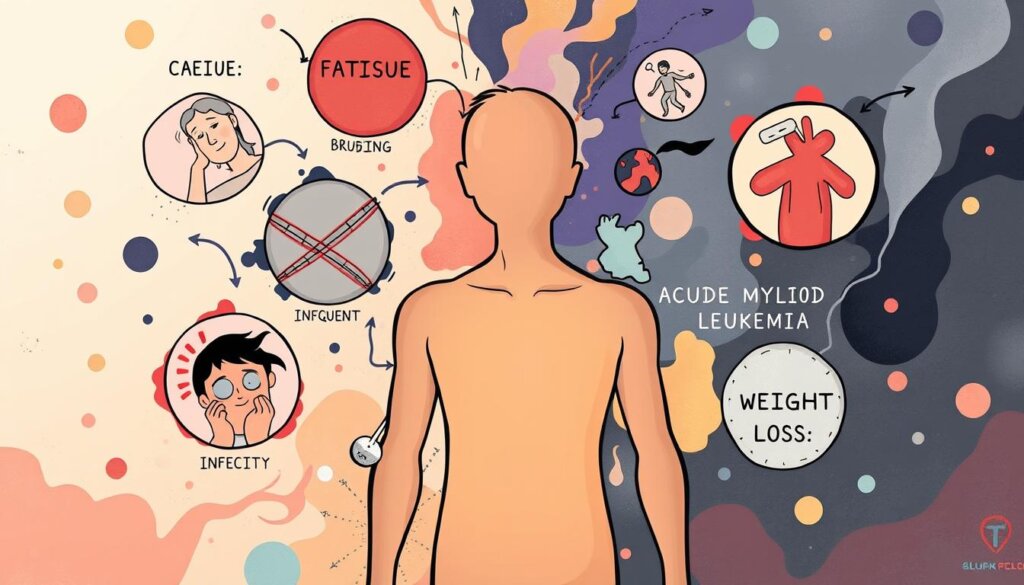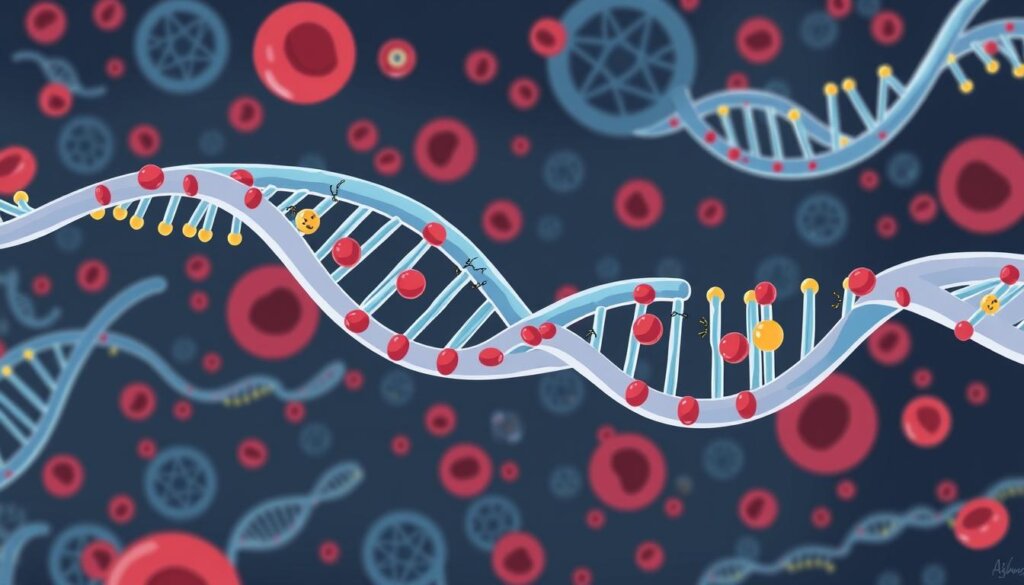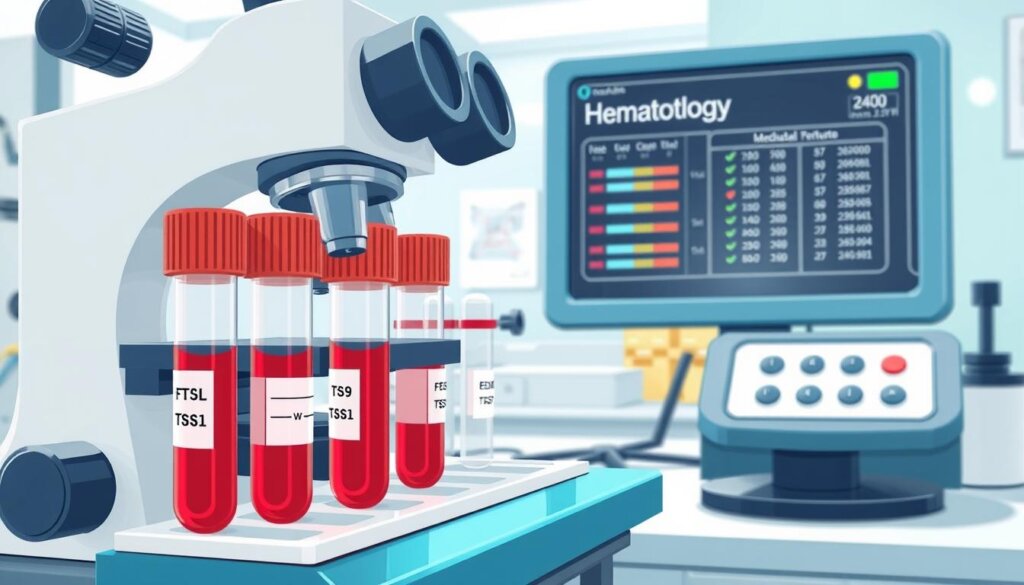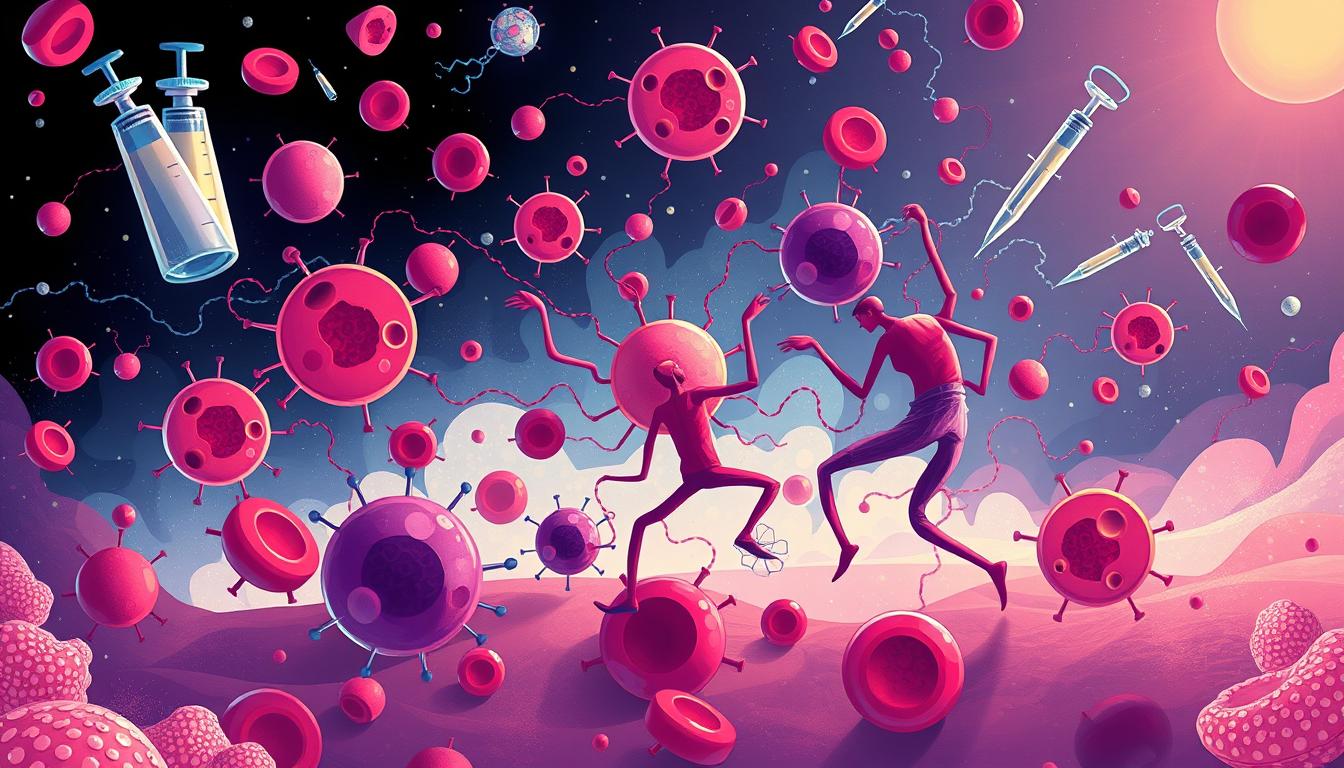FTC disclaimer: This post may contains affiliate links and we will be compensated if you click on a link and make a purchase.
Acute myeloid leukemia (AML) is a serious disease, hitting nearly 20,000 Americans yearly. It mostly affects people over 65, but it can also hit kids. This fast-moving cancer of the blood and bone marrow needs quick action. It can take over healthy blood cells, causing many bad symptoms.
Knowing the causes, symptoms, and treatments for AML is key. It helps give the best care and support to those with this blood cancer.
Key Takeaways
- Acute myeloid leukemia (AML) is a cancer that affects the blood and bone marrow, rapidly crowding out healthy blood cells.
- AML typically affects older adults, but it can occur at any age, including in children.
- Symptoms of AML can include fatigue, frequent infections, easy bruising, and bleeding due to low blood cell counts.
- Risk factors for AML include age, exposure to certain chemicals and radiation, and underlying genetic conditions.
- Treatment for AML often involves chemotherapy, targeted therapy, and potentially a stem cell transplant.
What is Acute Myeloid Leukemia?
Acute myeloid leukemia (AML) is a blood cancer. It affects the myeloid cells in the bone marrow. These cells should turn into different blood cells, like red and white blood cells, and platelets.
In AML, the bone marrow makes too many immature cells called myeloblasts. These cells take over, leaving no room for healthy blood cells. AML is called “acute” because it grows fast if not treated.
Defining Acute Myeloid Leukemia
AML is a blood cancer that starts in the bone marrow and spreads quickly. It can move to other parts of the body, like the liver and spleen. It usually comes from cells that would become white blood cells, except for lymphocytes.
Types and Subtypes
There are many subtypes of AML, each with its own genetic changes. These changes can affect how the disease behaves and how it’s treated. AML is also known as acute myelocytic leukemia and other names.
In short, AML is a fast-growing blood cancer. It affects the bone marrow, causing too many immature cells and not enough healthy ones. Knowing the exact subtype of AML is key to finding the right treatment.

Symptoms of Acute Myeloid Leukemia
Acute myeloid leukemia (AML) is a rare cancer mostly seen in people over 65. Its symptoms can vary but often include fever, fatigue, loss of appetite, and weight loss. These signs can be like the flu, making it hard to diagnose early.
Symptoms Caused by Low Blood Cell Counts
AML symptoms come from low blood cell counts in the bone marrow. Anemia makes you tired, dizzy, and short of breath. Neutropenia raises the risk of infections. Thrombocytopenia causes easy bruising and bleeding.
In severe cases, AML can lead to dangerous infections or serious bleeding.
General Symptoms
AML can cause headaches, confusion, and vision problems if it spreads to the brain. Other symptoms include feeling weak, fever, frequent infections, and easy bruising. You might also lose weight without changing your diet and look pale.
Early detection of AML is key because treatment must start quickly. If you notice these symptoms, see a doctor right away for the best chance of treatment.

Symptom | Description |
|---|---|
Fatigue | Feeling weak or tired, with potential general weakness and fatigue. |
Fever | High temperature or fever. |
Infection | Frequent infections, making individuals more susceptible to ailments like coughs and colds. |
Bruising and Bleeding | Bruising or bleeding easily, with occurrences like nosebleeds, bleeding gums, and very heavy periods. |
Anemia | Shortness of breath (breathlessness) due to potential anemia from a lack of red blood cells. |
Weight Loss | Weight loss without a change in diet. |
Bone and Joint Pain | Pain in the bones or joints, exhibiting dull aches or stabbing pains. |
Abdominal Discomfort | Feeling full in the abdomen due to swelling of the liver or spleen. |
Paleness | Paleness or a washed-out appearance due to insufficient red blood cells. |
Swollen Lymph Nodes | Swollen lymph nodes and lumps on the skin, which are less common symptoms. |
“The earlier acute leukemia is identified, the more successful the treatment is likely to be.”
Causes and Risk Factors
AML’s exact causes are still a mystery, but we know it’s linked to genetic changes in bone marrow cells. These changes mess up blood cell growth, causing too many immature cells. Many risk factors can make someone more likely to get AML.
Genetic Changes and Mutations
Genes that control cell growth can mutate, leading to AML. Mutations in FLT3, c-KIT, and RAS genes are common in AML. Chromosome changes like translocations and deletions are also seen in AML cells.
These changes can make AML different in each person. Most of these DNA changes happen during a person’s life, not from their parents.
Potential Risk Factors for Acute Myeloid Leukemia
Getting older increases the risk of AML because gene changes happen more often. AML is more common in men, but why is not clear. Smoking can also raise the risk, as it exposes the body to harmful substances.
Being around chemicals like benzene, found in cigarettes, can increase AML risk. People who had cancer treatment with certain drugs are also at higher risk. Getting a lot of radiation, like from an atomic bomb, can also raise the risk.
People with blood disorders like MDS or myeloproliferative neoplasms are more likely to get AML. Genetic syndromes like Fanconi anemia and Down syndrome also raise the risk. Having a family history of AML, especially in twins, can also increase the risk.
Research is looking into other possible links, like electromagnetic fields and chemical exposure at work. But the evidence is still not strong enough.

“Identifying the genetic changes and risk factors associated with AML is crucial for developing targeted treatments and improving patient outcomes.”
Acute Myeloid Leukemia Diagnosis
Diagnosing acute myeloid leukemia (AML) starts with a complete blood count (CBC) and blood smear. These tests look for leukemic cells and check blood cell types.
Next, a bone marrow biopsy and aspiration are done. This confirms the diagnosis and gives more details about the AML subtype.
Tests like cytogenetic analysis, flow cytometry, and genetic testing are key. Cytogenetic testing finds chromosomal changes that help decide treatment. Fluorescent in situ hybridization (FISH) spots chromosome changes not seen by standard tests.
Flow cytometry looks at proteins on leukemic cells, helping identify the AML subtype. Genetic testing, including next-generation sequencing, finds important AML gene mutations.
The number of blast cells in bone marrow or blood is very important for AML diagnosis. AML is diagnosed with at least 20% blasts in these areas. Normal bone marrow has less than 5% blasts.
Other tests like cytochemistry, immunohistochemistry, and molecular genetic analysis help confirm AML and plan treatment.
With a detailed diagnostic approach, doctors can accurately identify AML subtypes. They then create a treatment plan tailored for each patient.

Acute Myeloid Leukemia Treatment Options
AML treatment often starts with a two-phase chemotherapy plan. The first phase, called induction chemotherapy, quickly lowers leukemic cell numbers. It uses drugs like cytarabine and anthracyclines, such as the “7+3” protocol.
Some patients get targeted therapies like midostaurin or gemtuzumab ozogamicin to help. For brain or spinal cord leukemia, intrathecal chemotherapy and radiation might be needed. Patients stay in the hospital and have bone marrow biopsies to check treatment progress.
After remission, consolidation chemotherapy aims to keep the cancer away. Younger patients might get high-dose cytarabine or stem cell transplants. Older or sicker patients might get less intense treatment.
The choice of consolidation treatment varies based on several factors. These include how well the patient responds, donor availability, and health status. Some patients might also have a third phase of maintenance therapy.
New targeted and immunotherapies are being tested in AML trials. These could offer better treatment options for patients.
“The specific treatment plan for AML will depend on the patient’s age, overall health, the subtype of AML, and response to initial therapy.”
AML treatment is tailored to each patient. Healthcare teams decide the best plan based on individual needs. Ongoing research and trials aim to find better ways to fight this disease.
Statistic | Value |
|---|---|
Estimated new cases of Acute Myeloid Leukemia (AML) in the United States in 2024 | 20,800 |
Estimated deaths from AML in the United States in 2024 | 11,220 |
5-year survival rate for AML (2013-2019) | 31.7% |
Median age at AML diagnosis | 69 years |
Percentage of adults with AML who achieve complete remission after induction therapy | 60-70% |
Percentage of adults with AML who survive 3+ years and may be cured | More than 25% |
Percentage of AML patients with chromosomal abnormalities | Around 50% |
Cumulative incidence of congestive heart failure after treatment with anthracyclines | 5% at 400 mg/m2, 26% at 550 mg/m2 |
10-year cumulative incidence of congestive heart failure in AML vs. ALL patients | 7.5% vs. 1.7% |
Increased risk of frailty in hematopoietic cell transplant survivors compared to siblings | 8.4 times more likely |
Complications of Acute Myeloid Leukemia
Acute myeloid leukemia (AML) can cause serious problems. The low blood cell counts can result in anemia, thrombocytopenia (low platelets), and pancytopenia (low levels of all blood cell types), which can increase the risk of infection, bleeding, and other problems. Sometimes, a high number of leukemic cells can block blood vessels. This is called leukostasis and can harm tissues by not delivering enough oxygen.
Some AML types, like acute promyelocytic leukemia, raise the risk of bleeding and clotting. Complications for AML patients include major bleeding, sepsis, venous thrombosis, renal failure, liver dysfunction, respiratory failure, and cardiac arrest.
Being single, having low income, no health insurance, or other health issues can make AML worse. But, getting treatment at special cancer centers can help.
AML patients need to work with their doctors to manage these risks. Regular checks, early action, and a full care plan can help patients live better and fight the disease.
“The complications of acute myeloid leukemia can be severe, but with proper management and support, patients can navigate these challenges and focus on their recovery.”
Living with Acute Myeloid Leukemia
Living with acute myeloid leukemia (AML) is tough, but there’s help. Learning to cope and finding support are key. They help deal with the disease’s physical and emotional effects.
Coping Strategies
Keeping a positive outlook is vital when facing AML. By focusing on what you can control, you find strength. Stress management, like meditation or yoga, also helps.
Getting emotional support from loved ones or groups is also crucial. Sharing your story with others who get it can make you feel less alone.
Support Resources
There are many resources for AML patients and their caregivers. Advocacy groups, counseling, and palliative care teams offer help. They assist with symptoms and emotional support.
Talking openly with your healthcare team is important too. They help you understand your treatment and manage side effects. This ensures your physical and emotional needs are met.
“The journey with leukemia is not an easy one, but with the right support and coping strategies, patients can find the strength to overcome the challenges and live their best lives.”
Coping Strategies | Support Resources |
|---|---|
|
|
By using these coping strategies and support resources, people with AML can face their journey with hope. They can improve their life quality.
Clinical Trials and Emerging Therapies
Researchers are working hard to find new treatments for acute myeloid leukemia (AML). Clinical trials are key in testing these new treatments. They look at targeted agents and immunotherapies that use the body’s immune system to fight cancer.
In recent years, AML treatment has made big strides. In 2017, the U.S. Food and Drug Administration approved four new treatments. These include therapies for the FLT3 mutation, CD33-positive AML, and IDH2 mutations. These new treatments have shown better results and longer survival for those with these mutations.
New therapies for AML are being developed all the time. They target many different molecular markers, like B-cell lymphoma 2 and FLT3. There are also cell-based therapies using engineered T cells. These new methods offer hope for better lives for AML patients, especially those with relapsed or refractory disease.
Even though AML treatment has not changed much in decades, especially for older people, recent discoveries have led to new targeted therapies. These therapies are for specific types of AML.
Joining clinical trials can give AML patients access to these new therapies. It also helps in making treatments more personalized and precise for this tough disease.
Emerging AML Therapies | Target |
|---|---|
Midostaurin | FLT3 mutation |
Gemtuzumab ozogamicin | CD33-positive AML |
CPX-351 | Therapy-related AML or AML with myelodysplasia-related changes |
Enasidenib | IDH2 mutation |
Venetoclax | B-cell lymphoma 2 |
Chimeric antigen receptor (CAR) T-cell therapy | Cell-based immunotherapy |
The future of AML treatment looks bright. Researchers are always finding new ways to fight this disease. They are working on clinical trials that could greatly improve patient outcomes.
“The treatment of AML has seen limited advancement over the past few decades, particularly for elderly populations unfit for intensive therapy, resulting in generally poor outcomes.”
Conclusion
Acute myeloid leukemia (AML) is a serious blood cancer. It needs quick diagnosis and specific treatment. Understanding genetic mutations and demographic factors helps doctors create better care plans for each patient.
Even though AML treatment has gotten better, more research is needed. This is to find new ways to treat it more effectively. Survival rates have improved, but there’s still a lot to learn.
Knowing about the latest research and finding the right support can help those with AML. This article shows how important early detection and ongoing research are. They help improve how AML is managed and treated.
Doctors and patients must keep working together. They need to make sure everyone gets the right treatment and access to new trials. By staying informed and managing AML well, people can live better lives.
FAQ
What is acute myeloid leukemia (AML)?
AML is a fast-growing cancer of the blood and bone marrow. It affects the myeloid cells. This leads to too many immature myeloblasts, pushing out healthy blood cells.
What are the common symptoms of AML?
Symptoms include fever, fatigue, and loss of appetite. You might also lose weight, bruise easily, and get sick often. These signs come from low blood cell counts.
What causes AML, and who is at risk?
AML is caused by genetic changes in bone marrow cells. Risk factors are age, past cancer treatment, chemical exposure, and genetic disorders like Down syndrome.
How is AML diagnosed?
Tests for AML include a complete blood count (CBC) and blood smear. A bone marrow biopsy is also needed. More tests help find the AML subtype.
What are the main treatments for AML?
Treatments are chemotherapy and sometimes a stem cell transplant. New therapies and immunotherapies are being tested in trials.
What are the potential complications of AML?
Complications include anemia, low platelets, and a risk of infection and bleeding. Leukostasis, where cells block blood vessels, is also a concern.
How can patients cope with living with AML?
Patients can use coping strategies and seek emotional support. Resources like patient groups and counseling help manage the disease’s challenges.
What are the latest developments in AML research and treatment?
New treatments like targeted therapies and immunotherapies are being developed. Clinical trials offer hope for better treatments, especially for relapsed or refractory AML.








